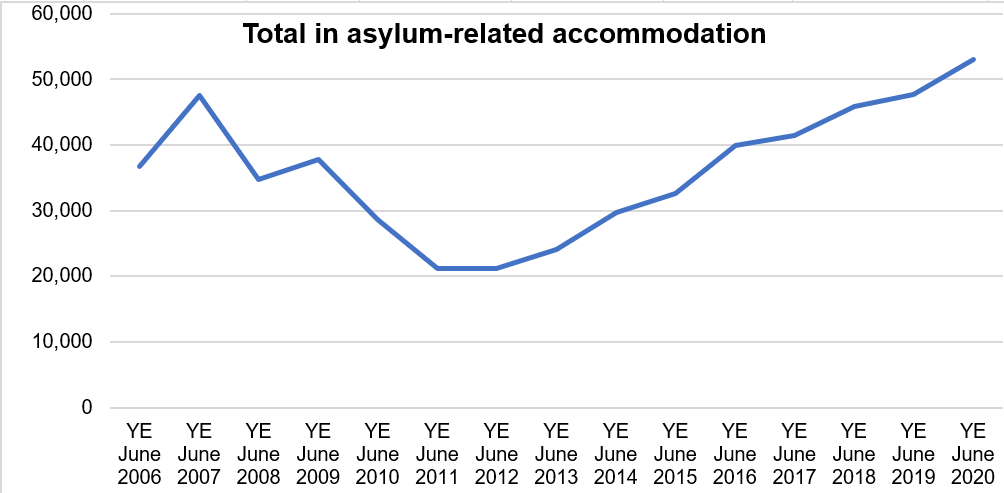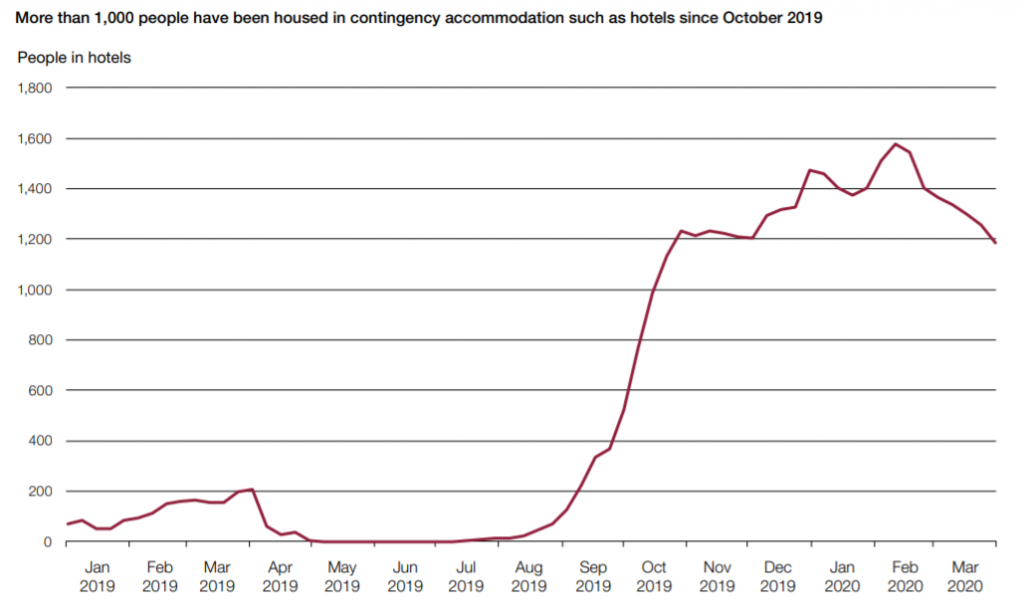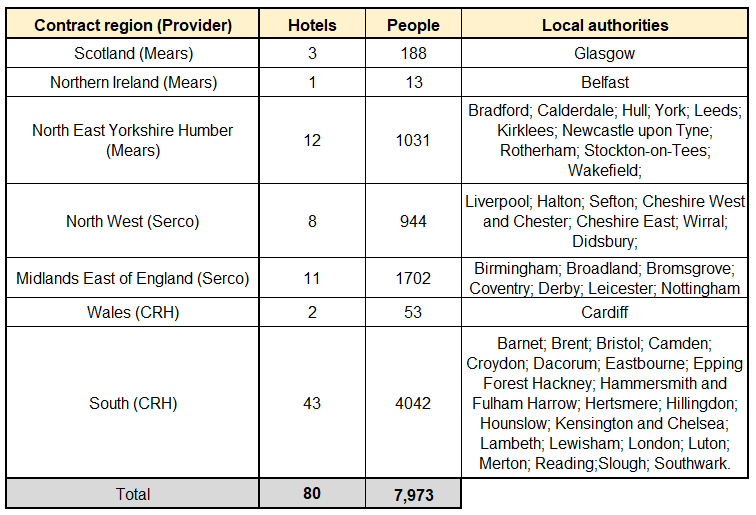The UK’s asylum system is being overwhelmed and abused (see our paper). One symptom of the beleaguered state of the system is that the number of people housed at taxpayer expense has tripled since 2012.
In the year to September, the total number of people housed stood at 60,000 – the population of a small city – and even includes thousands of people who do not even have any right to be in the UK. Accommodating and supporting asylum seekers, and failed claimants, is costing the taxpayer about £400m per year, according to the National Audit Office, or £4 billion from 2019 to 2029.
Figure 1: Home Office statistics on those given asylum accommodation under the Immigration and Asylum Act 1999.

The number of asylum claimants accommodated in hotels and barracks has also risen – shooting past 10,000 – with 9,500 in hotels and over 600 men housed on former military property in Wales and Kent, with hundreds more planned for rural Hampshire.
Those in hotels form a portion of asylum seekers housed in what is known as ‘initial accommodation’ – which also includes hostels and, from Monday 21 September 2020, a number in disused Army Barracks. In some locations, this is self-catering and cash is given to the asylum-seeker, in order to buy food (Section 98 factsheet). Between September 2019 and February 2020, on average people spent 26 days in initial accommodation before leaving. However, some stay nearly three months.
According to the latest Home Office statistics, the number accommodated by such means increased significantly between 2013 and mid-2020 (Home Office asylum support figures).
The initial rocketing of the numbers housed in initial accommodation such as hotels occurred in 2019 after illegal Channel crossings rose, and well before the pandemic hit from late January 2020 (as detailed in the following graph produced by the National Audit Office – see Fig.11 of their report).

More than 10,500 people have been reported illegally arriving across the Channel in the past two years – 2019 and 2020 (see our Tracker). 98% of those arriving this way in the first part of 2020 claimed asylum. Those deemed destitute can be ‘immediately’ placed in wuch housing which is generally full-board.
According to the government, around 81% of illegal Channel crossers whose application has been considered during a period of last year were deemed not to have a credible asylum claim in the UK – For more on this figure, see evidence by head of Home Office’s Visas and Immigration department to the Home Affairs Select Committee on 3 September 2020 (Q29 of transcript).
The number of claimants continued to rise as Channel crossings reached peak after peak during 2020 (the worst-ever month was September 2020 with nearly 2,000 reported arrivals).
There were just over 4,400 asylum seekers in 53 full board hotels at the end of June and this rose to nearly 8,000 people in 80 hotels at the end of August. By early October, the number had risen to 9,500 in 91 hotels in about 50 local authorities around the country (Home Office evidence to House of Commons Public Accounts Select Committee). The table below shows the numbers housed in hotels by region at the end of August.
Table 1: Asylum seekers in hotels by region on 24 August 2020. Source: Letter from the Permanent Secretary for the Home Office to the Chair of the Public Accounts Committee (4 September 2020).

There might have been others accommodated in half-board hotels, hostels or other contingency accommodation (see House of Commons Library report). For instance, sites at Napier barracks in Kent and Penally Barracks in Pembrokeshire, Wales between them hold more than 600 men and there are plans to house 500 more in rural Hampshire at Barton Stacey.
Asylum seekers who are deemed to be destitute can then be moved into long-term ‘dispersed accommodation’ around the country until their asylum claim has been dealt with – mostly in urban areas in more deprived parts of the country – under Section 95 of the same law (failed asylum seekers with children can also be housed under this provision), while failed asylum seekers who are deemed eligible can also be housed under Section 4 (about 5,000 were in the most recent year).
The significant rise of the numbers in both initial and dispersed accommodation from early 2020 has also been linked both to the Covid crisis and the fact that the government temporarily ceased ending asylum support for those whose claims have been either granted or refused ‘in order to ensure people were not made homeless during lockdown’.
Home Office personnel confirmed there have been 122 cases of Covid in hotels housing asylum seekers, which accommodate many illegal entrants and failed claimants (see Q49 of link). According to one MP, the Home Office then ‘move[d] [asylum claimants] who were positive for coronavirus out of a hotel and into other parts of the country, including Hammersmith, without informing the local authorities, thereby spreading the virus across the country’. In another case, those confirmed as having Covid-19 were moved to Coventry from Birmingham.
As a government minister said in a letter to MPs in December 2020: “Asylum seekers are provided with accommodation and support to meet their essential living needs, both before an inadmissibility decision is made and after the inadmissibility decision and before their removal, if they would otherwise be destitute. After a decision is made on their claim and before their removal, they may be entitled to support as a failed asylum seeker.”
Our research suggests that housing an estimated 20,000 or so failed claimants (based on figures for the year to June 2020) may be costing the taxpayer £130 million per year, although we would welcome clarification on this from the government which has so far declined to provide figures.
This despite the fact that the Conservative government repealed the main provision for doing this in 2016. So why is it continuing despite the law having been repealed?
The asylum system is getting more and more overstretched as a backlog of cases increases (harming genuine claimants and wasting taxpayer money), as abuse ‘increases’ (according to the Home office) and as immigration enforcement is sabotaged from above by Ministers – via savage cuts and a weakening of the rules – on the command of ‘woke’ immigration activists.
We have made a number of suggestions for how immigration enforcement should be toughtened up and the asylum system made more efficient.
